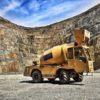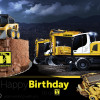MEDIUM EXCAVATORS PROVE VERSATILE WORKHORSES

“These machines [crawler excavators weighing 60,000 to 80,000 pounds] are used across a wide range of applications, across a number of industries, and can be found working most everywhere, from heavy infrastructure projects, to underground utilities, road construction, pipeline, commercial site prep, demolition—you name it,” says Brian Stellbrink, Caterpillar excavator market professional. “These machines strike a critical balance of being big enough to complete large scale work, yet are easy to transport from job to job.”
According to John Bauer, brand marketing manager, Case Construction Equipment, “these are strong earthmovers—not quite your mass-excavation-sized machine, but large enough to move lots of earth on large projects.”
Among the largest buying segments in this size category, says Bauer, is the rental industry, given that contractors using these machines often are decentralized and find it easier to rent close to their work, rather than own machines and to pay to transport them three or four states away.
Matt Hendry, product consultant, hydraulic excavators, at John Deere Construction & Forestry, takes note of the power that machines in this size category exhibit, relative to their modest footprint on the job site.
“The 350-class [35 metric-ton] machine is a wonderfully sized excavator, because you can do a lot of really big work with it, yet it’s relatively easy to transport and you can use it on sites where it’s actually too much machine for the project—but it fits. It’s a very versatile machine.”
COST OF OWNERSHIP
Size class, pounds Avg. Price Hourly Rate* 53,000-62,000 $279,000 $160 63,000-73,000 $306,000 $180 74,000-88,000 $346,000 $200 *Hourly rate represents the monthly ownership costs divided by 176, plus hourly operating cost3.
Source: EquipmentWatch.com
According to Volvo Construction Equipment’s Matthew McLean, excavator product manager, “this range [60,000 to 80,000 pounds] represents the workhorse-size class of machines and speaks for a critical share of the overall excavator market.”
Volvo, says McLean, sees machines at the lower end of this weight spectrum, the Volvo EC250E and EC300E, for instance, as crossover units—“meaning that they split the difference between tool carriers and production-digging machines,” he says. On the other hand, says McLean, the model EC350E, which in its lightest configuration (narrow tracks and light counterweight) has an operating weight just touching 80,000 pounds, would be, in his words, “an entry-level, production-class excavator.”
Placing machines in neat, operating-weight categories is difficult, however, because variations in basic configuration can substantially affect working weights. For example, McLean cites the Volvo EC300EL, which in its lightest configuration weighs 64,720 pounds, but gains nearly 5,000 pounds when fitted with wide tracks, heavy counterweight and heavy-duty boom and arm.
Kurt Moncini, product manager, large excavators at Komatsu America, notes that a configuration variation for some models in this size category is the long front—such as Komatsu’s Super Long Front PC290LC-10 and PC360LC-10 models, which have a reach at ground level of nearly 60 feet. The specialty nature of these machines, he says, makes them popular rental items.
Long-front machines can reach out another 20 to 30 feet, compared with their conventional counterparts, and still remain on solid ground, says Moncini, usually having some reinforcement of the base machine and a heavier counterweight to take on applications that typically involve constructing and maintaining waterways and settlement ponds.
Shane Reardon, Doosan excavator product specialist, adds dimension to the capabilities of the long-front excavator: “The Doosan DX300LC-5 with a super-long-front configuration, compared with its conventional counterpart, increases digging reach from 34 feet 6 inches to 57 feet; digging depth from 23 feet 11 inches to 45 feet 2 inches; and loading height from 23 feet 10 inches to 39 feet 3 inches.”
Reardon does, however, add a caution, as do most manufacturers offering long-front machines: “Our super-long-front excavators should not be confused with special demolition-type long-fronts and booms.”
(If a demolition front is allowed by the manufacturer for a particular machine, the package typically is available only from aftermarket suppliers and is designed to work with the specific machine’s mass.)
John Deere’s Hendry, though, makes the point that a long-front machine need not be limited to special, relatively light-duty applications. He notes that he has seen some machine owners buy both a long front and a convention front for their machine, switching between the two as applications vary. A fixture in the contractor’s yard, he says, stores the long front when not in use.
Weights and configurations aside, Case’s Bauer sums up the general state of the market for 60,000- to 80,000-pound machines and the general expectations of buyers in this market: “The market is healthy—more than doubled since 2010. When a contractor gets into equipment of this size, they’re clearly looking for production. As they compare machines at the lower end of this range to the higher end, there’s really no deal-breaking change in footprint, so many buyers will favor the heavier machines to get the added reach and lifting capabilities.”
Says Doosan’s Reardon, “the 35-metric-ton size class (33 to 40 tons) represents the largest market in North America and is the fastest growing segment in the crawler-excavator category, according to Association of Equipment Manufacturers data.”
Eric Pang, hydraulic excavator platform manager for Sany, concurs. “Customers continually emphasize the need for production from machines of this size, followed perhaps by fuel efficiency and versatility.”
TAIL SWING
Although limited-tail-swing excavator models typically have been in the lower-metric-ton classes, these compact-radius machines seem now to be moving up in weight. Specifications for the Kobelco SK260SRLC-3, for example, show the 59,300-pound machine having a tail overhang (when the upper is at 90 degrees to the tracks) of 7.5 inches when fitted with 31.5-inch shoes.
Caterpillar also recently introduced two new relatively heavy machines with limited tail swings, the nearly 60,000-pound 325F L and the 335 L CR at a bit more than 80,000 pounds. Equipped with 31.5-inch shoes, these models, according to Caterpillar specifications, have a tail overhang when working over the side of 5.5 and 7.5 inches, respectively.
“Many contractors are looking for machines that can work on congested job sites, yet have enough lift capacity to handle large structures, large-diameter pipe, and trench boxes,” says Caterpillar’s Stellbrink.
The Volvo ECR305, weighing up to 82,320 pounds, and the ECR235EL, weighing in at 60,180 pounds in its heaviest configuration, have a tail overhang of 3.5 inches and 8 inches, respectively, with 31.5-inch shoes.
EMISSIONS CONTROL
Although excavator manufacturers employ various strategies to reach Tier 4-Final emissions compliance—depending on the design of the engine, its size, and desired performance characteristics—all are striving for unobtrusive operation, as Caterpillar’s Stillbrink sums up:
“Our approach is simple: Do not let emissions [control] disrupt the job-site process. If the operation [of controls] is transparent to operators, they can focus on the job, while controls function in the background.”
A number of manufacturers, however, do not use a diesel particulate filter (DPF) in their emissions-control strategy for machines in this size range, among them Doosan, Case, Sany, and Hitachi. Mark Wall, product marketing manager, Hitachi Construction Equipment, makes the point that Hitachi’s Dash-6 models in this weight category use Tier 4-Final Isuzu engines with specifically tuned EGR (exhaust-gas recirculation) systems that minimize the use of diesel exhaust fluid for nitrogen oxide control. In addition, says Wall, a new piston design allows particulate matter to be burned effectively in-cylinder, eliminating the need for a DPF.
GRADE-CONTROL/TELEMATICS ADVANCES
Grade-control systems for dozers and motor graders continue to offer advanced technology for more precisely (and automatically) controlling elevations and contours. Although innovative grade-control systems are available for hydraulic excavators, these systems, generally, have not yet reached the level of machine control that is possible with dozers and graders. (Only 25 percent of fleet managers say they use the technology, according to Construction Equipment research, page 26.)
But work is continuing in this regard. Komatsu, for example, recently developed an “intelligent Machine Control” (iMC) system for its PC210LCi-11 and, according to the company’s Moncini, the technology is being applied to larger machines.
“Komatsu is attempting to give less-experienced operators 20 years of experience by letting the machine work for them,” says Moncini.
The iMC system uses a sensor package that includes stroke-sensing hydraulic cylinders, an inertial-measurement-unit sensor and GNSS antennas. Three-dimensional design data in the control box checks bucket position, and if the bucket hits the target surface, it is semi-automatically limited to minimize over-excavation. If the operator turns off the system’s Auto mode, the machine can be operated with an indicate-only system.
John Deere’s Hendry also sees the technology of automated grade control expanding for hydraulic excavators, but not without challenges. “Going forward, the hydraulic-excavator market will likely see the same kind of growth and system abilities that are in motor graders and dozers. At present, though, the challenge of sensing in-place utilities is an impediment to full grade control on hydraulic excavators.”
Hendry also sees telematics as becoming more instrumental in increasing the overall efficiency of the excavator, especially the capability of telematics to facilitate remote diagnosis.
“The ultimate goal,” he says, “is to allow the technician—the first time he touches the machine—to have the parts on the truck.”












